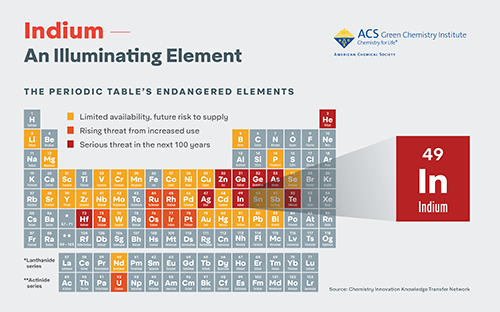What is Indium?
Indium is a silvery-white metal named for its indigo blue line in the atomic spectrum. Relatively scarce on the Earth’s crust, indium is found with zinc sulfide ores, as well as iron, lead and copper ores.
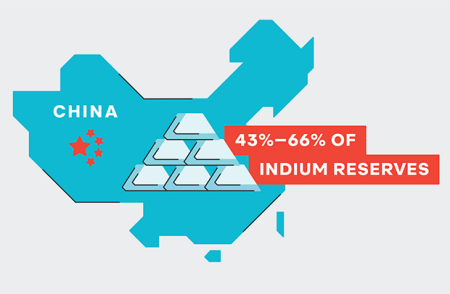
Where is Indium from?
The vast majority (~90%) of indium is isolated as a byproduct of zinc mining. The top producers of indium are China (40%), Korea (31%), Canada (9%) and Japan (9%).
There is no indium production in the United States. China controls between 43% and 66% of the world's indium reserves.
How is Indium Used?
Indium tin oxide, an electrical conductive film used to make LCD displays and photovoltaic panels, accounts for 45% of all indium usage. Other uses include specialty alloys, microchips and semiconductors.
Sustainable indium usage in solar panels is critical to helping us meet U.N. Sustainable Development Goal #7: Affordable and Clean Energy.
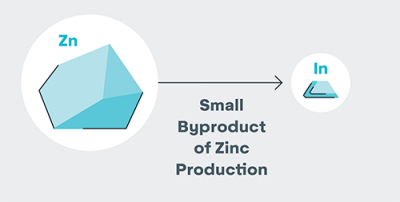
Why is Indium a Critical element?
- The world's supply of indium is dependent on zinc mining.
- Indium recovery from post-consumer LCD scrap is cost prohibitive.
Growth in the use of LCDs and touch screens, as well as the expanding solar cell industry, are driving global demand for indium. Supply is dependent upon the zinc mining industry of which indium is a small byproduct. Zinc itself is a critcal and endangered element. Because of its dependence on zinc mining, it is difficult to rapidly increase the supply of indium. Unless the price of indium rises dramatically, additional sources of indium will not be economical to exploit.
Indium recycling occurs in the indium tin oxide manufacturing process to increase the efficiency of the process. However, with only small amounts of the element in any given device, recovering indium from post-consumer LCD scrap is cost prohibitive.
What Can We Do to Save Indium?
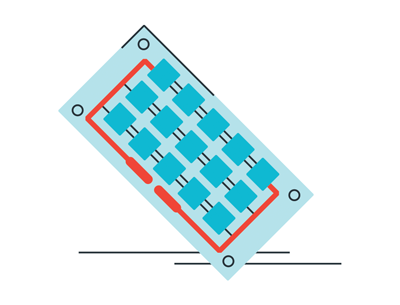
Chemists
- Research on reducing the amount of indium used in LCD displays (e.g., indium zinc oxide has comparatively less indium than the
traditional indium tin oxide). - Research on alternatives to indium in LCDs from more abundant materials, such as antimony, carbon nanotubes and conductive polymers.
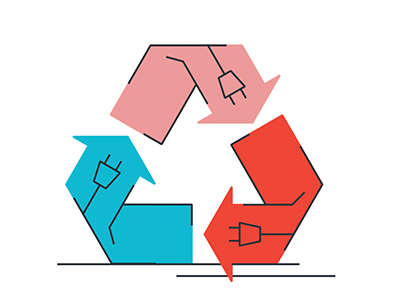
Institutions
- Support company take-back programs: It is easier to recycle a single stream of the same product from the same brand than mixed devices.
- Increase the efficiency of extracting indium from mines. Currently only 20% of indium is recovered.
- Increase the e fficiency of the current indium tin oxide production process.

Individuals
- Extend the life of your LCD screens (phone, computers and tvs) by upgrading less often and donating devices.
- Recycle old devices and screens rather than storing them in your house or workplace.
-
1. Lokanc, M.; Eggert, R.; Redlinger, M. The Availability of Indium: The Present, Medium Term, and Long Term. NREL/SR-6A20-62409. October 2015. https://www.nrel.gov/docs/fy16os/62409.pdf.
2. U.S. Geological Survey, Mineral Commodity Summaries, February 2019, pp 78-79. https://prd-wret.s3-us-west-2.amazonaws.com/assets/palladium/production/s3fs-public/atoms/files/mcs-2019-indium.pdf.
3. Fortier, S.M.; Nassar, N.T.; Lederer, G.W.; Brainard, J.; Gambogi, J.; and McCullough, E.A. 2018, Draft critical mineral list—Summary of methodology and background information—U.S. Geological Survey technical input document in response to Secretarial Order No. 3359: U.S. Geological Survey Open-File Report 2018–1021, 15 p., https://doi.org/10.3133/ofr20181021.
4. Deakin, J. Turner, K. How will we save our endangered elements? Educaon in Chemistry. February 11, 2019. https://eic.rsc.org/feature/how-will-we-save-our-endangered-elements/3010098.article.

